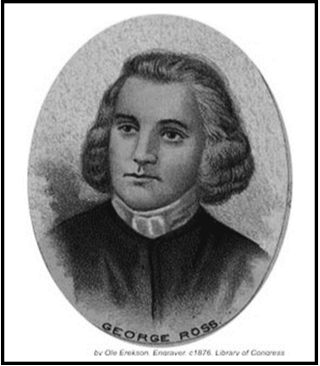George Ross
DAR Ancestor Number: A098405
Service: Signer of the Declaration of Independence /
Civil Service, PA
Residence: Lancaster, Lancaster Co., PA
Birth: 10 May 1730, New Castle, New Castle Co., DE
Married: Ann Lawlor 17 Aug 1751
Death: 14 Jul 1779, Philadelphia, Philadelphia Co., PA
Burial: Christ Church Burying Ground, Philadelphia, PA
Proven children: George, James
George Ross's Biography
George Ross was the child of Reverend George Ross Sr. and Catherine Van Dezel. George Sr. left the Presbyterian ministry for the Church of England and came from Scotland to Delaware circa 1703.[1] The son George, who is the subject of this biography, was born 10 May 1730[2] in New Castle, DE.[3]
George and his wife Ann had two sons and one daughter, George b. 1 Jun 1752, d. 13 Nov 1832, m. Mary Bird 3 Apr 1773; James b. circa 1752, d. Aug 1808, m. Mary Sabino circa. 1769; and Mary b. 3 Dec 1765, m. James Wilson.
After George completed his preparatory studies, he began to study law at the age of eighteen; he was admitted to the bar in 1750 and commenced practice in Lancaster, PA.[4] He was a member of the colonial assembly from 1768-1776 and a delegate to the State convention in 1774.[5] Despite his Loyalist leanings, a provincial convention to which Ross had been elected sent him to the Continental Congress at Philadelphia in 1774.[6] He was a latecomer to the Revolutionary cause.
The next year, by which time he had for some reason decided to affiliate with the Revolutionaries, he also served on the Pennsylvania Council of Safety and held a militia colonelcy; and in 1776 he assisted in negotiating a peace treaty with the Indians in northwestern Pennsylvania.[7]
He was among the foremost leaders in the provincial legislature in espousing measures for the defense of the community against British aggression and in 1775 drew up a reply to a message of Governor Penn that deprecated any defensive measures on the part of the colonies.[8]
In 1775 he was listed as a Colonel associated with the First Battalion for Lancaster County.[9] George was appointed judge of the court of admiralty for Pennsylvania 14 April 1779 and served in that capacity for three months until his death near Philadelphia, PA.[10] Judge Ross possessed a benevolent disposition, which often led him to espouse the cause of the Indians and to save that people from the consequences of the frauds that were practiced on them by the whites.[11] As a lawyer he was early classed among the first of the profession, and as a judge he was learned and upright, and remarkable for the ease and rapidity with which he dispatched business. He was the last man of the Pennsylvania delegation to sign the Declaration of Independence.[12]
In March 1778 while he was Deputy Quartermaster General of the Lancaster County Militia, he wrote a letter in response to Colonel Gibson’s request for four wagons for the purpose of conveying clothing to headquarters. George regretted to inform Colonel Gibson that it is out of his power to furnish such request until he sends off an Express to the W. Master General of Lancaster County.[13]
Like many others, he exerted more influence in state than national affairs. In 1778 while Ross was acting as admiralty judge in Pennsylvania, a congressional court of appeals overruled his decision in a case involving a dispute between a citizen of Connecticut and the Commonwealth of Pennsylvania. Ross, refusing to acknowledge the authority of the higher court to counter state decisions, initiated a dispute between Pennsylvania and the Central Government that represented an early manifestation of the states rights controversy and did not subside until 1809.[14]
But George did not live to see the outcome; he died 14 Jul 1779 at the age of forty-nine. He is buried in Christ Church Burying Ground, Philadelphia, PA[15] which includes the resting place of Benjamin Franklin and other signers of the Declaration of Independence. A note of interest is that Ross’ nephew, John Ross, married Elizabeth Phoebe Griscom, better known as Betsy Ross.[16]
On 2 May 1895 Mary Elizabeth Ross was the first woman to prove her lineage and service to her great-grandfather George Ross. Both her father and grandfather were named George. As of March 2022, seventy women globally have proven they are a descendant of George Ross through sons James or George.
[1] James Grant Wilson and John Fiske, Appletons' Cyclopedia of American Biography, Vol. V, New York: D. Appleton & Company, 1888, p. 328.
[2] Joint Committee on Printing Congress of the US, Biographical Directory of the United States Congress, United States: Government Printing Office, p. 1838.
[3] Wilson and Fiske, p. 328.
[4] Joint Committee, p. 1838.
[5] Ibid.
[6] Robert G. Ferris and Richard G. Morris, The Signers of the Declaration of Independence, Arlington, VA: Interpretive Publications, 1982, p. 122-123.
[7] Ibid.
[8] Wilson and Fiske, Appletons' Cyclopedia of American Biography, p. 328.
[9] PA Archives, Fifth Series, Vol. V, p. 13, 19.
[10] Wilson and Fiske, p. 328.
[11] Ibid.
[12] Ibid.
[13] PA Archives, First Series, Vol. VI, p. 324-325.
[14] Ferris and Morris, The Signers of the Declaration of Independence, p. 122-123.
[15] Joint Committee, Biographical Directory of the United States Congress, p. 1838.
[16] https://www.ushistory.org/betsy/.

